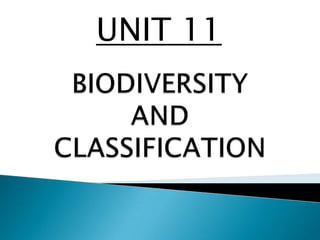
Unit 11 biodiversity and classification
- 1. UNIT 11
- 2. Biodiversity refers to the total number of species found in an area. Includes the large variety of species, different ecosystems and genetic differences. Endangered species: species in danger of extinction Threatened species: species likely to become endangered in the near future
- 4. Ecologists describe biodiversity as an attribute of three other levels of biological organization: ◦ Genetic diversity: variation among members of a population, higher genetic diversity – higher chance of survival. ◦ Community diversity: community composition, increases the levels of biodiversity. ◦ Landscape diversity: a group of interacting ecosystems within one landscape.
- 5. Biodiversity not evenly spread throughout biosphere ◦ Protecting some areas will save more species than protecting other areas Regions of the world are called biodiversity hotspots ◦ Contain unusually large concentrations of species CAPE REGION
- 6. INDIGENOUS SPECIES Occurs in a place naturally Native A species can be indigenous to a number of places at once ENDEMIC SPECIES Occurs naturally only in that place. Native to an exclusive or limited area. Not widely distributed – won't be found naturally anywhere else. e.g. Madagascar Flying Fox endemic to Madagascar
- 7. More than a million species of living organisms discovered and described ◦ Estimated ±30 million species still to be discovered Scientists involved in describing species are called taxonomists
- 8. Plant & animal species identified exhibit great deal of variation ◦ In form, structure, mode of life & other aspects Plants & animals need to be divided into discrete groups based on the differences ◦ In order to study them.
- 9. Classification: the scientific practice of identifying, naming and grouping of living organisms. Branches of biology that deal with classification: ◦ Taxonomy deals with describing and naming organisms. ◦ Systematics deals with grouping and arranging the described taxa into a hierarchical classification.
- 10. Makes studying living organisms convenient. Helps in specific identification of an organism. Study of a few representatives from each distinct group helps to integrate idea of life as a whole. Reveals relationships among various groups of organisms. Provides information about plants and animals occurring in specific geographical regions. Indicates evolutionary relationship ◦ Establishing gradually increasing complexity of form and structure in different groups of organisms.
- 11. ARISTOTLE (Greek philosopher) ◦ 1st to classify organisms ◦ Either as plants or animals ◦ He formulated the 2 kingdom system = Plantae and Animalia ◦ Plant group subdivided into 3 smaller groups: shrubs, herbs, and trees. ◦ Animals subdivided into groups according to where they lived: on land, water or in the air.
- 12. Ernest Heackel Proposed adding a third kingdom = Protista Robert Whittaker (1969) Expanded the classification system to five kingdoms Organisms were placed in these kingdoms based on type of cell, complexity, and type of nutrition All prokaryotes were placed in the monera kingdom. ◦ Organisms without a membrane bound nucleus
- 13. Carl Woese (1970) Proposed 2 groups of prokaryotes after researching the rRNA ◦ Bacteria ◦ Archaea These also fundamentally different from each other Should be assigned to separate domains ◦ (higher classification category than a kingdom). Thus formulated a 3 domain system = Bacteria, Archaea and Eukarya
- 15. Linnaeus’s System Carolus Linnaeus (Swedish Botanist) developed a method of classifying organisms properly. Based on classifying according to physical & structural similarities. ◦ E.g. he might use the similarities in flower parts as a basis for classifying flowering plants. Became foundational way for today’s modern classification systems.
- 16. Modern classification systems use a two-word naming system called Binomial Nomenclature ◦ Bi: two ◦ Nomial: associated with a name Species is given a unique and stable name Meant that each species is composed of two Latinised words (similar to name & surname) 1. Genus 2. species
- 17. First word identifies the genus name of the organism. A genus (plural form = genera) consists of a group of similar species. Second word, the species, often describes a characteristic of the organism. Scientific name = the Genus name + species name
- 18. Example: Homo sapiens (wise man) Note: Genus name begins with capital letter Species name begins with lower case letter. Both names are always italicized or underlined Example: Sutherlandia frutescens or Sutherlandia frutescens
- 19. Latin is the language of scientific names Many organisms have common names just like you might have nicknames. Example: ◦ Sutherlandia frutescens (scientific) ◦ Cancer bush / Kankerbos (common) Accepted by speakers of all languages Each name applies only to one species Each species has only one name
- 20. A Kingdom is the largest group in the classification system Encompasses all the related species Living organisms are subdivided into 5 major kingdoms: ◦ MONERA ◦ PROTISTA ◦ FUNGI ◦ PLANTAE ◦ ANIMALIA ◦ (Organisms cannot belong to more than one)
- 21. Kingdom Monera Consists of all bacteria – simple, single celled organisms with no nucleus
- 22. Kingdom Protista Consists of single celled or simple multi- cellular organisms Some obtain energy by photosynthesis – algae. Some ingest other organisms Some absorb molecules through the cell membrane E.g. Amoeba, Euglena.
- 23. Kingdom Fungi: Single celled –e.g. yeast- to multi cellular organisms Body composed of very fine threads – saprophytic nutrition
- 24. Kingdom Plantae: Plants Multi cellular terrestrial organisms Cells have cell walls, obtain energy through photosynthesis Kingdom Animalia: Animals Multi cellular, aquatic and terrestrial organisms Cells have no cell wall, feed on other organisms
Notas do Editor
- The Archaea are a group of single-celled microorganisms. Eukarya: The domain comprised of eukaryotes or organisms whose cells contain a true nucleus
